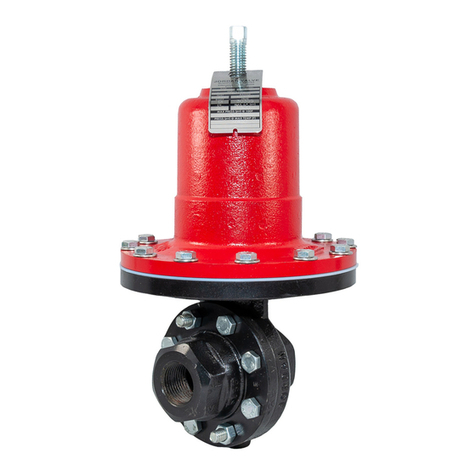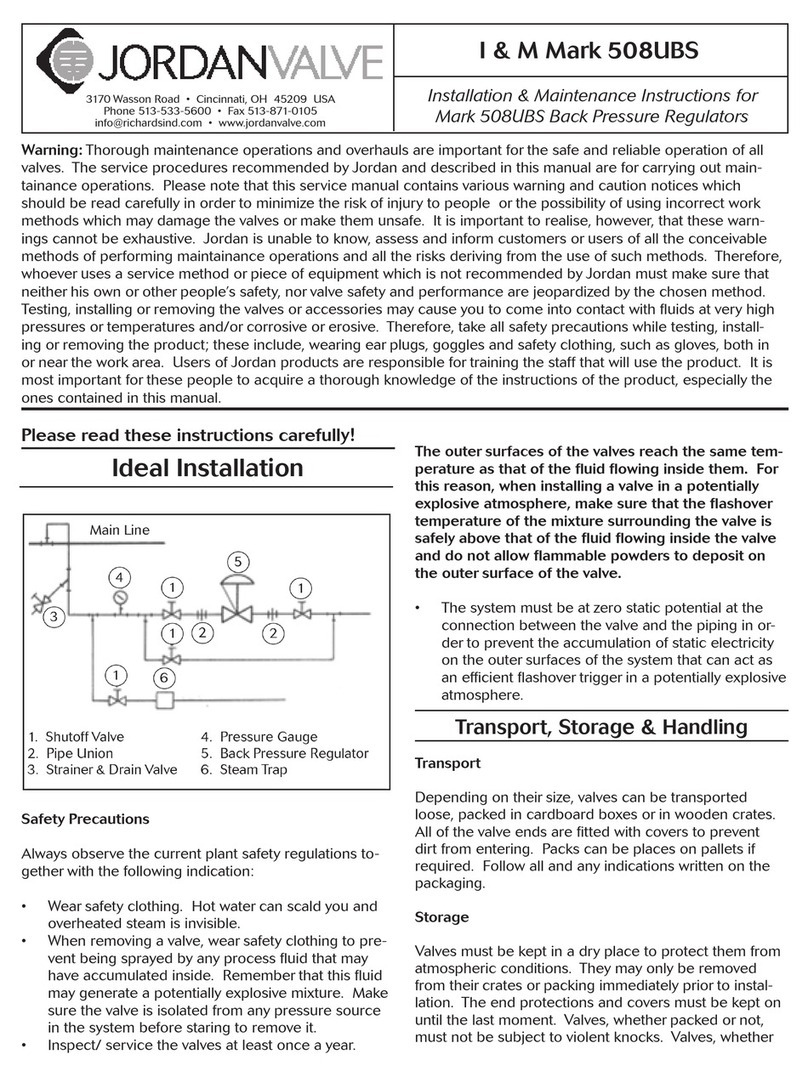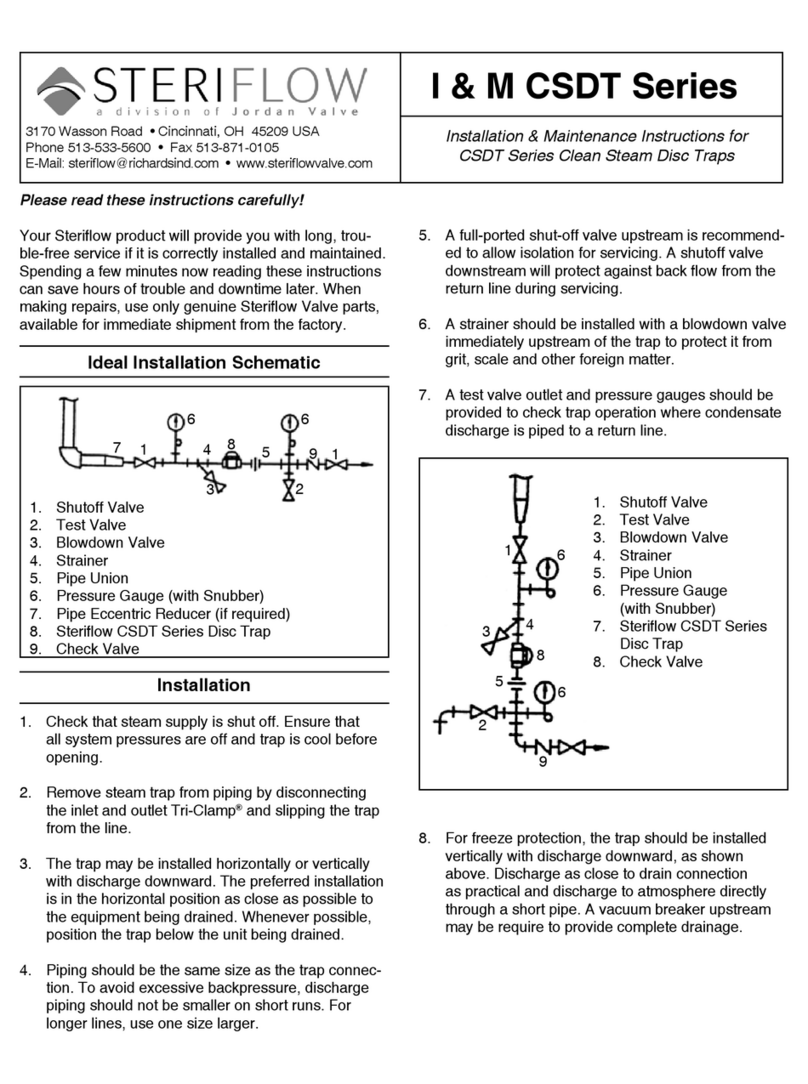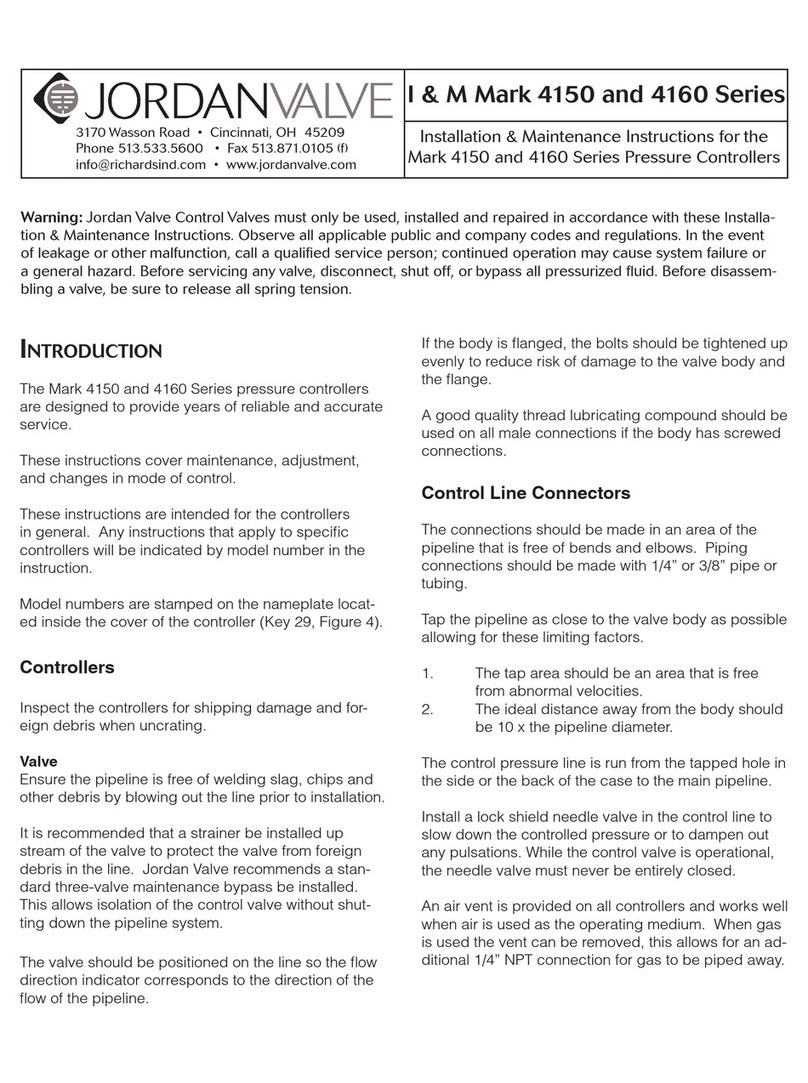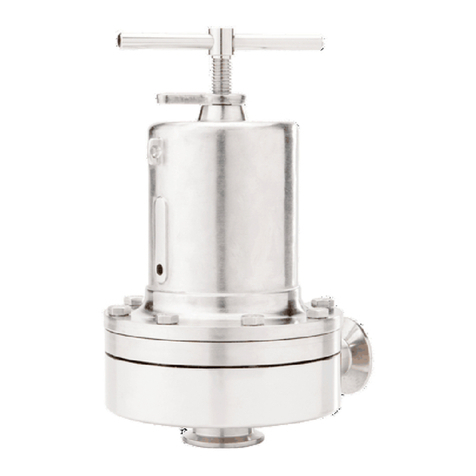
Note: Refer to the drawing at the end of this document for
description and proper orientation of parts.
Valve Seats
A. Disassembly
Jordan Valve Sliding Gate Seats are lapped to light band
flatness. Maintaining such tolerances is of paramount im-
portance for your assurance of excellent control and tight
shutoff. DO NOT use metallic objects in removing the seats.
Care in handling is important.
1. Following the Maintenance procedures to remove the valve
from line.
2. Note scribes (<) on the side of the body (12) and cap (19).
Secure the body flats in a vise. Remove the cap bolts (20)
and two nuts from the studs. Lift the cap straight up.
3. Remove the disc guide (18) by lifting straight up - protect
the lapped surfaces on both sides of the disc guide. Before
removing, check the disc (17) for a stamped arrow. This
arrow points to the "<" on the valve body. (NOTE: discs that
can be rotated 180° without affecting the stroke may not
have arrows.) Lift straight up on the disc (17). Place the disc
on the bench lapped surface facing up. Remove the index
pin (21).
It is imperative that the disc pin (14) assembly is not rotated
when disassembling, cleaning or reassembling, since this
affects the stroke adjustment of the valve.
4. Invert the body and lightly tap on the exterior to remove the
plate (16). Let the plate drop out into your hand, and place
it on the bench with the lapped surface facing up. If the plate
sticks lightly tap on the back of the plate with a soft blunt
object; push the plate (16) out evenly.
5. Clean all the parts , body and cap with solvent. Insert body
and cap bores for damage. If the parts are scarred, do not
attempt to relap them, but return them to the factory for re-
pair or replacement.
6. The vertical sections of the disc guide (18) serve as guides
for the disc (17) while stroking. A 0.005 feeler gauge should
be used to check for clearance between this surface and
the side of the disc. If the clearance is less, clean the guide
surfaces in the disc guide with a fine file.
B. Reassembly
1. Lightly coat the outer ring on the unlapped side or the plate
(16) with anti-seize compound.
2. Place the plate (16) in the body, lapped surface facing the
cap. The index-pin hole should be on the same side of the
body as the "<" on the body. Align the disc pin (14) so that it
is centered in the body bore and that it protrudes through
the center slot in the plate (16). Place the disc (17) on the
plate (16), engaging the disc pin (14). The arrow on the disc
(17) should point to the index-pin hole. Insert the index-pin
(21) in the hole.
3. Coat the outer ring on the side of the disc guide without the
index pin hotel, with a light coating of anti-seize compound.
4. Place the disc guide onto the plate (16), engaging the index-
pin (19). Rotate the assembly slightly until the slot openings
in the disc are parallel to the openings in the plate, and
perpendicular to the stem. Stroking the valve will aide in
this alignment.
5. Align the ">" on the cap (19) with the "<" on the body (12),
and place the cap over the two studs in the body.
6. Install the nuts and cap bolts (20). Tighten uniformly. See
back page for torque requirements and tightening proce-
dures.
Diaphragm Replacement
A. Disassembly
1. Remove all of the compression from the spring (7) by rotat-
ing the adjusting screw (1) counterclockwise until it moves
freely.
(Failure to remove the compression from the spring could
result in personal injury or damage to the valve.)
2. Remove the spring housing bolts (5) and spring housing
(4). Remove the spring (7) and spring seat (6).
3. Remove the diaphragm assembly by rotating counterclock-
wise. The diaphragm assembly consists of the upper dia-
phragm plate (8), diaphragm (9) and lower diaphragm plate
(10).
4. If the diaphragm must be replaced, secure the upper dia-
phragm plate (8) in a vise. A 3/16” face spanner wrench
should be used to remove the lower diaphragm plate (10)
from the assembly.
5. Remove the diaphragm (9) and reassemble in reverse or-
der.
B. Assembly and Stroke Adjustment
1. Note that the valve stroke adjustment is determined by how
far the diaphragm assembly is screwed onto the stem. Screw
the diaphragm assembly onto the stem until the disc pin is
centered in the valve body.
2. Push the diaphragm assembly down against the valve body
and check the orifice alignment of the disc (17) and the
plate (16). The orifices should be fully open and in perfect
alignment.
3. If the orifices are not in perfect alignment, rotate the dia-
phragm assembly counterclockwise to lower the disc, and
clockwise to raise the disc.
4. The total stroke of the Mark 60 is equal to the orifice width
plus 1/32" overlap. Consequently, perfect adjustment is re-
quired for proper operation.
5. When seats are in perfect alignment, Proceed with the
assembly of the spring housing.
6. Place the spring (7) on the upper diaphragm plate (8) and
the spring seat (6) on the spring.
8. If the diaphragm is metal, be sure that the diaphragm is
aligned in the body recess. This recess also aligns the spring
housing (4). Be sure that the bleed hole is facing down-
stream.
9. If the diaphragm is elastomer, make sure that after the seats
Disc Pin (14)
Index Pin (21)
Cap Screws (20)
Hext Nuts (2)
Body (12)
Studs (2)
Valve Plate (16)
Valve Disc (17)
Disc Guide (18)
Cap (19)

